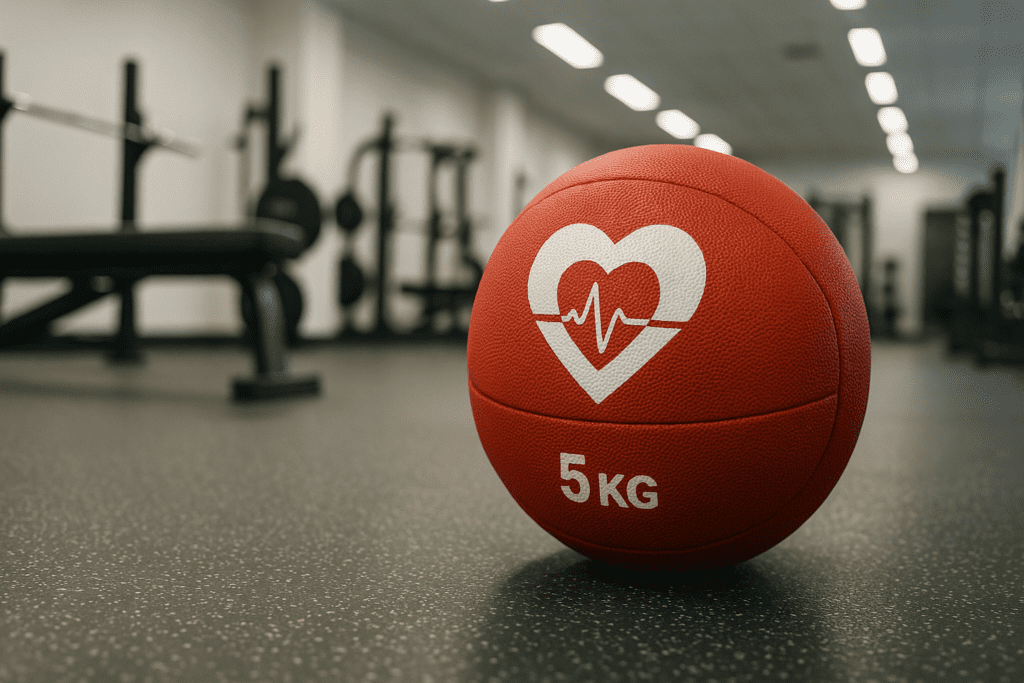Strength training is often associated with bulging muscles and athletic performance, but for many adults—particularly beginners seeking improved heart health—the benefits go far beyond physique. In recent years, mounting clinical evidence has highlighted the cardioprotective effects of resistance training, especially when incorporated as part of a structured, beginner-friendly fitness plan. For those new to fitness, starting with a starter weight training program can not only support muscular strength and endurance but also contribute significantly to overall cardiovascular health. This dual benefit makes weight training one of the most valuable yet underutilized tools in preventive cardiology.
You may also like: Top Cardiologist-Approved Cardio Workouts to Improve Cardiovascular Fitness and Heart Health Naturally
As public awareness around heart health grows, more individuals are turning toward lifestyle-based interventions. While aerobic activity remains central to most guidelines, combining cardiovascular exercise with strength training for beginners is now considered the gold standard. The American Heart Association supports resistance-based exercises for their ability to regulate blood pressure, reduce visceral fat, and improve metabolic function—all of which are integral to long-term cardiovascular wellness. This article explores the science, structure, and safety of beginning strength training from a heart-focused perspective, with guidance on how a starter weight lifting routine can be both accessible and transformative for cardiovascular health.
Understanding the Cardiovascular Benefits of Resistance Training for Beginners
At its core, resistance training for beginners activates skeletal muscles in a way that enhances glucose metabolism, oxygen consumption, and vascular function. For those new to exercise, this process initiates improvements in arterial flexibility and endothelial function—key markers of cardiovascular resilience. While traditional aerobic exercise has long been touted for its heart benefits, newer research suggests that beginner strength workouts can rival or even surpass aerobic-only programs in certain cardiovascular outcomes, particularly in reducing hypertension and managing insulin sensitivity.
A major advantage of beginner weight lifting is its ability to lower resting blood pressure without the repetitive joint stress often seen in running or high-impact cardio routines. When performed consistently, even a basic weight lifting routine of compound and bodyweight-based movements can yield reductions in systolic and diastolic blood pressure over time. This is particularly important for individuals with prehypertension or a family history of heart disease who may not yet require medication but still benefit from lifestyle modification.
Another often-overlooked benefit is how beginner strength training for women and men alike helps in reducing central obesity—one of the most significant risk factors for cardiovascular morbidity. Weight training stimulates lean muscle growth, which in turn boosts resting metabolic rate and facilitates fat loss, particularly visceral fat that surrounds the organs. This internal fat is metabolically active and has been linked to increased inflammation, lipid dysregulation, and insulin resistance. By reducing it, strength exercises for beginners serve as a protective shield for the heart, making them an essential part of a heart-healthy regimen.
How a Starter Weight Lifting Routine Supports Cardiac Output and Circulatory Efficiency
Many new exercisers are unaware that starting a weight lifting program enhances cardiovascular performance not by mimicking aerobic endurance but by improving peripheral circulation, stroke volume, and oxygen utilization at the muscular level. As you engage in a beginner weight routine, the heart adapts by increasing its efficiency during both rest and effort. This happens through mechanisms such as increased capillarization, improved venous return, and stronger contractility of the left ventricle.
Moreover, a thoughtfully designed beginner lifting workout emphasizes tempo control, rest periods, and progressive overload—all of which condition the cardiovascular system to respond more effectively to physical stress. For instance, a circuit-based strength training program for beginners that includes squats, rows, and push-ups not only strengthens major muscle groups but also elevates heart rate within a safe and beneficial range. Over time, this dynamic effort reduces the heart’s workload by enhancing stroke volume, meaning the heart can pump more blood with fewer beats.
One of the most valuable aspects of a beginner weight training plan is its scalability. Because strength training allows for gradual increases in resistance and complexity, it suits individuals with varying degrees of cardiovascular capacity. This includes people with controlled hypertension, mild arrhythmias, or even stable coronary artery disease under medical supervision. With appropriate progression, beginner weightlifting can evolve into a lifelong practice that fosters muscular and cardiovascular synergy without placing undue strain on the heart.

Addressing Safety Concerns When Beginning a Weight Training Program
Despite its numerous benefits, some people hesitate to begin resistance training due to misconceptions about its safety, especially for those with heart concerns. The reality is that a medically guided and properly executed weight training regimen for beginners is not only safe but advisable for most individuals seeking better heart health. The key lies in customization and progression. Before embarking on a starter weight training plan, individuals—particularly those with known cardiovascular issues—should obtain medical clearance and consider working with a certified exercise physiologist or clinical fitness specialist.
The early phases of a novice strength program should focus on mastering body mechanics rather than lifting heavy weights. Emphasizing form, breathing techniques, and core stability reduces the risk of musculoskeletal injury while protecting cardiovascular integrity. Holding one’s breath during exertion, for example, can trigger a spike in blood pressure through the Valsalva maneuver—something that can be avoided with proper instruction. In contrast, controlled exhalation during the concentric phase of lifts is a foundational component of safe beginner weight training for women and men.
Additionally, those following a beginner weight lifting workout should monitor their response to exercise by paying attention to heart rate, perceived exertion, and recovery times. Tracking these markers helps determine whether the intensity level is suitable and ensures that the heart is adapting appropriately. The American College of Sports Medicine recommends a frequency of two to three non-consecutive days per week for beginners, with at least 48 hours of rest between sessions for similar muscle groups. This frequency strikes a balance between stimulus and recovery, which is vital for both muscular and cardiovascular adaptation.
Key Components of a Safe and Effective Beginner Strength Workout
To build a sustainable and heart-friendly fitness habit, a beginner weight training plan should include fundamental movement patterns that engage large muscle groups while also stimulating cardiovascular demand. Exercises such as goblet squats, dumbbell presses, bent-over rows, and glute bridges are excellent examples of weight lifting exercises for beginners that encourage multi-joint involvement. These movements not only improve strength and mobility but also elicit moderate increases in heart rate, supporting cardiovascular conditioning.
When structuring a strength training program for beginners, it’s important to focus on full-body workouts rather than isolated muscle group splits. Full-body training ensures that each major muscle group receives adequate stimulation multiple times per week, promoting balanced development and metabolic efficiency. Including movements that target both the upper and lower body also prevents muscular imbalances and reinforces postural alignment—an important consideration for cardiovascular health, as good posture supports optimal lung expansion and venous return.
For those training at home, weight training for beginners at home can be just as effective as gym-based routines. Resistance bands, bodyweight exercises, and household items like water jugs or backpacks can substitute for traditional weights, making this modality accessible to all. The goal is not to lift heavy right away but to establish a consistent rhythm and gradually increase resistance over time. As strength and confidence improve, so does cardiovascular fitness, forming a symbiotic relationship between muscular and heart health.
Why Strength Building for Beginners Matters More Than Ever in Cardiovascular Prevention
The prevalence of cardiovascular disease continues to rise globally, driven by lifestyle factors such as inactivity, poor diet, and metabolic dysfunction. In this context, strength building for beginners emerges as a proactive strategy for reducing disease risk before symptoms manifest. Even modest increases in muscular strength are associated with significant reductions in cardiovascular mortality and morbidity, according to large-scale population studies. This protective effect is amplified when resistance training is combined with moderate aerobic activity and healthy dietary practices.
What sets beginners strength training workouts apart is their accessibility. Unlike high-intensity sports or complex aerobic programs, beginner lifting routines can be modified for virtually any ability level and performed in a wide range of settings. This adaptability is particularly crucial for older adults, women re-entering fitness, and individuals recovering from sedentary lifestyles. For instance, weights for beginners female programs often emphasize core control, joint support, and functional strength, all of which contribute to better cardiovascular outcomes by improving mobility, stability, and endurance.
Moreover, beginner weight lifting plays a unique role in improving mental health, which is closely tied to cardiovascular well-being. Strength training has been shown to reduce symptoms of anxiety and depression, both of which are independent risk factors for heart disease. By fostering a sense of control, progress, and resilience, weight training supports both psychological and physiological dimensions of cardiovascular care. In this way, a basic weight lifting routine becomes more than just a physical protocol—it becomes a comprehensive wellness strategy.
Building Confidence Through Structured Strength Training for Beginners
Starting a new fitness journey can be intimidating, especially for those who have never set foot in a gym or used resistance equipment. That’s why developing a beginner strength training for women or men plan that prioritizes confidence is critical. Progression, not perfection, should be the guiding principle. A well-structured program begins with foundational exercises that can be modified according to skill level. As technique and strength improve, resistance is gradually increased—either by adding weight, increasing repetitions, or reducing rest intervals.
One of the most effective ways to enhance adherence is through a beginner weight training plan that incorporates measurable milestones. Tracking improvements in performance—such as the number of push-ups performed or the amount of resistance handled—creates a positive feedback loop that motivates consistency. This sense of achievement is particularly important for individuals managing chronic conditions like hypertension or metabolic syndrome, who often feel disempowered by their diagnosis.
Creating a supportive environment is equally important. Whether training with a partner, a coach, or in an online community, accountability helps maintain momentum and provides encouragement during plateaus. Beginning a weight training program is not a linear process. There will be fluctuations in energy, motivation, and physical capacity. However, by committing to a structured routine and celebrating small victories, beginners can establish habits that translate to long-term cardiovascular resilience.

Avoiding Common Mistakes in Beginner Weight Training for Women and Men
While enthusiasm is valuable, beginners often fall into traps that hinder progress or compromise safety. One of the most common errors in a beginner weight training for women or men’s program is doing too much, too soon. Overtraining can lead to fatigue, injury, and elevated stress hormones—none of which support heart health. It’s crucial to respect recovery time and avoid comparing one’s progress to others.
Another pitfall is neglecting proper warm-up and cool-down procedures. A beginner weight routine should always start with five to ten minutes of dynamic movement, such as brisk walking or arm circles, to increase blood flow and prepare the cardiovascular system. After the workout, light stretching and deep breathing help the body return to a resting state and improve recovery.
Poor technique is another issue, especially in home settings where guidance may be limited. Utilizing resources such as instructional videos from reputable fitness professionals or seeking feedback from certified trainers can ensure correct form and reduce the risk of strain. Remember, a beginner lifting workout is not about impressing others or lifting the heaviest weight possible—it’s about learning proper mechanics and respecting your own starting point.
Frequently Asked Questions: Beginner Strength Training for Cardiovascular Health
1. How long should a beginner strength training workout last if my main goal is heart health?
A typical beginner strength workout aimed at improving cardiovascular wellness should last between 30 to 45 minutes, depending on your fitness level and exercise selection. This timeframe allows for an effective warm-up, a targeted starter weight lifting routine, and a proper cool-down period. What matters more than duration, however, is how you structure your workout. Circuits using compound weight lifting exercises for beginners—such as squats, rows, and presses—can elevate heart rate while building muscular strength. For optimal heart benefits, beginners can alternate resistance and active recovery phases, keeping rest periods short to maintain aerobic engagement throughout the session.
2. Can I combine cardio and weight training in one session, or should I alternate days?
You can safely combine cardiovascular activity and strength training for beginners in a single session, provided the intensity and duration are appropriate for your current conditioning. In fact, combining modalities is often ideal when pursuing heart health. One approach is to perform 20 minutes of cardio followed by a beginner lifting workout, or use supersets that incorporate short bouts of aerobic movement between sets. This method, often referred to as metabolic resistance training, can offer the dual benefits of endurance and strength building for beginners. For those who prefer alternating days, that strategy works well too—as long as each training type is performed at least twice per week to promote measurable results.
3. What are the best types of equipment for a weight training regimen for beginners focused on heart health?
Beginners don’t need expensive gym memberships to see cardiovascular benefits from resistance training. Some of the most effective tools include resistance bands, dumbbells, and even bodyweight. For those designing a starter weight training setup at home, adjustable dumbbells or kettlebells offer versatility without taking up much space. Resistance bands are great for joint-friendly strength exercises for beginners and allow for progressive overload through varying tension levels. Machines can also be helpful during the initial stages of a beginner weight training plan, especially for older adults or those recovering from cardiac-related issues. What’s essential is consistency and form—not the sophistication of the equipment.
4. Are there special considerations for women starting a strength training program for cardiovascular support?
Yes, while the physiological principles are largely the same, beginner strength training for women should often take into account factors like bone density, hormonal changes, and cultural training barriers. Weights for beginners female routines frequently incorporate movements that improve joint stability, balance, and pelvic floor engagement—areas often neglected in traditional strength programming. Many women also benefit from working with lighter weights initially to master form before increasing resistance. Importantly, resistance training can help mitigate cardiovascular risks that increase during perimenopause and postmenopause, particularly in terms of lipid management and blood pressure control. A personalized beginner weight routine can be both empowering and protective for long-term heart health.
5. What role does breathing play in beginning a weight training program for cardiovascular benefits?
Breathing is a cornerstone of both effective and safe weight lifting training for beginners, especially when heart health is a concern. Improper breathing—such as holding your breath during a lift—can sharply increase blood pressure and place unnecessary stress on the heart. Instead, use rhythmic breathing: exhale during the exertion phase (e.g., lifting or pressing) and inhale during the return phase. This technique helps stabilize intra-abdominal pressure while promoting venous return to the heart. Mastering proper breathing early in a novice strength program supports cardiovascular efficiency and minimizes risk, especially for those managing conditions like hypertension or arrhythmia.
6. How should I modify a strength training program for beginners if I have high blood pressure or a heart condition?
A beginner weight training plan can still be effective for those with hypertension or stable heart conditions, but modifications are necessary. Focus on low-to-moderate intensity resistance, avoid maximal lifts, and prioritize full-body movements performed at a controlled tempo. It’s wise to avoid isometric holds and ensure adequate rest between sets to allow the heart rate to return to a safe baseline. A beginner strength workout in this context should emphasize consistency over intensity, gradually building endurance and muscular support. Always consult a cardiologist or clinical exercise specialist before beginning any starter weight lifting routine, and consider heart rate monitoring for added safety.
7. How can a beginner weight lifting workout enhance mental health and stress resilience?
Strength training isn’t just beneficial for the heart muscle—it also supports emotional well-being, which is deeply intertwined with cardiovascular health. Engaging in a basic weight lifting routine has been shown to reduce symptoms of anxiety and depression through the release of endorphins and improved neurochemical balance. For many beginners, the structure and progression of a beginner weight training for women or men program fosters a sense of accomplishment and control. These psychological gains can lower perceived stress, reduce cortisol levels, and thereby support heart rate variability—a key marker of autonomic nervous system health. When paired with mindfulness or breathing strategies, beginner weightlifting becomes a holistic wellness practice.
8. Is there a specific time of day that’s best for beginner strength training when focusing on heart health?
There’s no universal “best” time to train, but circadian rhythms do influence cardiovascular function. Research shows that morning workouts may improve blood pressure response and metabolism, while afternoon sessions may allow for greater strength output due to higher core temperature. The key is consistency—whether you follow a beginner lifting workout in the morning or evening, sticking to a regular time can enhance adherence and results. Some individuals with heart-related conditions may benefit from avoiding very early morning sessions when blood pressure tends to spike. Ultimately, a strength training program for beginners should be scheduled during a time when energy, focus, and safety are most reliable for the individual.
9. How long does it typically take to see cardiovascular improvements from beginner weight lifting?
While muscle definition may take several weeks to become visible, cardiovascular benefits from beginning strength training often occur within the first month of consistent effort. Improvements in resting blood pressure, heart rate variability, and blood glucose levels can be seen within 3 to 6 weeks, especially when strength training is performed two to three times per week. A starter weight lifting routine supports endothelial function and stroke volume fairly early in the adaptation process. However, it’s important to note that progression varies depending on age, baseline fitness, and comorbid conditions. Incorporating weight training for beginners at home with aerobic movement and nutritional changes can accelerate results.
10. What are the best post-workout recovery strategies for someone following a beginner weight routine focused on heart health?
Recovery is often underestimated, yet it’s a critical component of any weight training regimen for beginners. After a beginner strength workout, focus on replenishing fluids and electrolytes to maintain optimal blood pressure and hydration. A light post-workout meal with protein and complex carbohydrates helps repair muscle tissue while supporting glycogen restoration. Gentle stretching, foam rolling, and deep breathing exercises can accelerate parasympathetic nervous system activation—helping the body shift into rest-and-digest mode. For those using a strength training program for beginners, prioritizing 7–9 hours of quality sleep also enhances cardiac and muscular recovery. Over time, strategic recovery allows the body to build resilience and strength without compromising cardiovascular stability.

Conclusion: Why a Beginner Strength Training Program Is One of the Best Investments in Your Heart
Embarking on a beginner weight lifting workout is more than an act of physical self-care—it’s a powerful step toward safeguarding your cardiovascular health. By enhancing muscular strength, improving metabolic efficiency, and supporting blood pressure regulation, strength training for beginners offers a multifaceted approach to heart wellness. Whether you’re training in a gym or exploring weight training for beginners at home, the consistent application of a well-designed routine can yield measurable, lasting benefits.
The path of beginner weightlifting is accessible to people from all walks of life. With a clear plan, appropriate guidance, and a mindset of gradual progress, individuals can overcome barriers and embrace a practice that supports not just heart function but also emotional well-being, bone health, and functional independence. As more studies affirm the protective role of resistance training in cardiovascular care, the time has never been better to adopt a starter weight lifting routine.
Above all, it’s important to remember that strength comes in many forms—and for those just beginning their journey, every rep is an act of prevention, empowerment, and self-respect. A strength training program for beginners doesn’t just build muscle—it builds confidence, energy, and a more resilient heart, one workout at a time.
heart-healthy workouts, beginner fitness for heart disease, low-impact strength training, cardiovascular exercise alternatives, muscle strength and heart health, safe workouts for hypertension, building endurance safely, resistance training at home, home workouts for heart patients, functional strength for longevity, heart rate control exercises, exercise for heart function, beginner-friendly cardio routines, metabolic fitness training, cardiac rehab exercises, circulatory system workouts, physical activity and heart wellness, aerobic vs resistance training, improving heart health through fitness, exercise prescription for beginners
Further Reading:
Get in shape in February with a walking and 15 strength training exercises for heart health
The Best Strength Training Exercises for Beginners
Is Weight Training Safe for Heart Patients? Understanding the Risks and Benefits
Disclaimer
The information contained in this article is provided for general informational purposes only and is not intended to serve as medical, legal, or professional advice. While MedNewsPedia strives to present accurate, up-to-date, and reliable content, no warranty or guarantee, expressed or implied, is made regarding the completeness, accuracy, or adequacy of the information provided. Readers are strongly advised to seek the guidance of a qualified healthcare provider or other relevant professionals before acting on any information contained in this article. MedNewsPedia, its authors, editors, and contributors expressly disclaim any liability for any damages, losses, or consequences arising directly or indirectly from the use, interpretation, or reliance on any information presented herein. The views and opinions expressed in this article are those of the author(s) and do not necessarily reflect the official policies or positions of MedNewsPedia.


